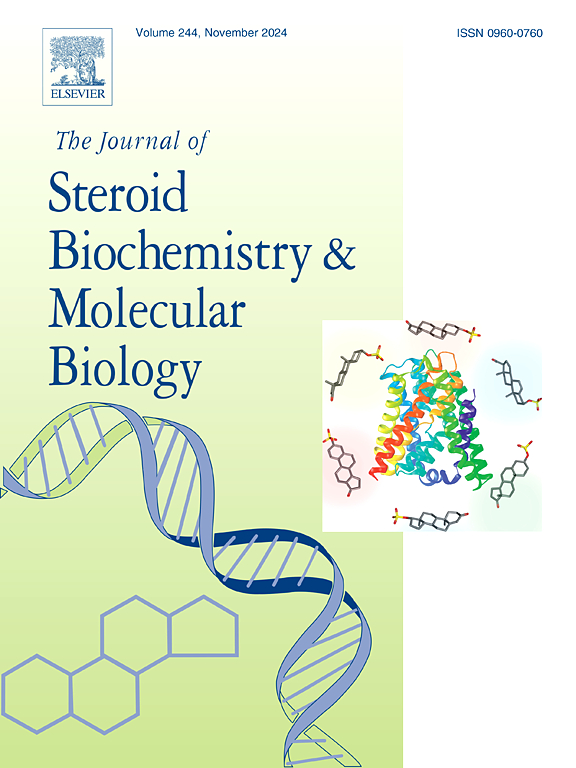G蛋白偶联雌激素受体通过调控IRE1α/miR-17-5p/TXNIP通路降低乳腺癌细胞存活
IF 2.5
2区 生物学
Q3 BIOCHEMISTRY & MOLECULAR BIOLOGY
Journal of Steroid Biochemistry and Molecular Biology
Pub Date : 2025-05-04
DOI:10.1016/j.jsbmb.2025.106770
引用次数: 0
摘要
本研究旨在探讨GPER是否可以通过ER和IREα激活SKBR3细胞系的UPR反应,并评估这种反应是导致细胞存活还是细胞死亡。此外,该研究还试图评估这种反应对细胞行为(如凋亡、迁移和耐药性)的影响。为了激活UPR并诱导内质网应激,我们用0.5 µg/ml TUN处理MCF10A细胞系24和48 h。采用qRT-PCR技术检测XBP-1和C/EBP同源蛋白(CHOP)基因(内质网应激标志物)的表达水平。以MCF10A + TUN细胞系为阳性对照。为了确定G1和他莫昔芬(TAM)的最佳剂量,我们使用qRT-PCR分析评估GPER表达。然后用不同剂量的G1(1000 nM)、G15(1000 nM)和TAM(2000 nM)单独或联合(G1 + G15、TAM + G15、G1 + TAM)处理细胞24和48 h。我们测量了GPER、IRE1α、MiR-17-5p、TXNIP、ABCB1和ABCC1基因的表达。流式细胞术检测细胞凋亡,创面愈合实验检测细胞迁移。我们的研究结果表明,G1和TAM激活GPER可显著增加SKBR3细胞中IRE1α的表达。这种激活通过其RIDD活性裂解了miR-17-5p并启动了UPR死亡反应。上调TXNIP基因表达可增强细胞凋亡和化疗敏感性,同时降低细胞迁移。有趣的是,G15治疗明显逆转了这些效果。综上所述,GPER/IRE1α/miR-17-5p/TXNIP轴在UPR促死亡反应中发挥关键作用,促进SKBR3细胞程序性死亡,减少迁移,降低耐药。本文章由计算机程序翻译,如有差异,请以英文原文为准。
G protein-coupled estrogen receptor reduces the breast cancer cell survival by regulating the IRE1α/miR-17-5p/TXNIP pathway
This study aimed to explore whether GPER can induce the UPR response in the SKBR3 cell line through ER and IREα activation, and to assess whether this response leads to cell survival or cell death. Additionally, the study sought to evaluate the impact of this response on cell behaviors such as apoptosis, migration, and drug resistance. To activate the UPR and induce ER stress, we treated the MCF10A cell line with 0.5 µg/ml TUN for 24 and 48 h. The expression levels of XBP-1 and C/EBP homology protein (CHOP) genes (ER stress markers) were measured using the qRT-PCR technique. The MCF10A + TUN cell line was used as a positive control. To determine the optimal doses of G1 and tamoxifen (TAM), we evaluated GPER expression using qRT-PCR analysis. Cells were then treated with various doses of G1 (1000 nM), G15 (1000 nM), and TAM (2000 nM), both individually and in combination (G1 + G15, TAM + G15, G1 + TAM), for 24 and 48 h. We measured the expression of GPER, IRE1α, MiR-17-5p, TXNIP, ABCB1, and ABCC1 genes. Apoptosis was assessed via flow cytometry, and cell migration was examined using the wound-healing assay. Our results demonstrated that GPER activation by G1 and TAM significantly increased IRE1α expression in SKBR3 cells. This activation, through its RIDD activity, cleaved miR-17-5p and initiated the UPR death response. The upregulation of the TXNIP gene expression enhanced apoptosis and chemotherapy sensitivity while decreasing cell migration. Interestingly, these effects were notably reversed by G15 treatment. In summary, the GPER/IRE1α/miR-17-5p/TXNIP axis plays a key role in the UPR pro-death response, promoting programmed cell death, reducing migration, and decreasing drug resistance in SKBR3 cells.
求助全文
通过发布文献求助,成功后即可免费获取论文全文。
去求助
来源期刊
CiteScore
8.60
自引率
2.40%
发文量
113
审稿时长
46 days
期刊介绍:
The Journal of Steroid Biochemistry and Molecular Biology is devoted to new experimental and theoretical developments in areas related to steroids including vitamin D, lipids and their metabolomics. The Journal publishes a variety of contributions, including original articles, general and focused reviews, and rapid communications (brief articles of particular interest and clear novelty). Selected cutting-edge topics will be addressed in Special Issues managed by Guest Editors. Special Issues will contain both commissioned reviews and original research papers to provide comprehensive coverage of specific topics, and all submissions will undergo rigorous peer-review prior to publication.

 求助内容:
求助内容: 应助结果提醒方式:
应助结果提醒方式:


